| Home |
| Acknowledgments |
| Conventions |
| Glossary |
| Maps |
| References |
| Links |
| Articles |
| Thumbnails |
| Species
list |
| Family |
| Next
species |
Additional Photos
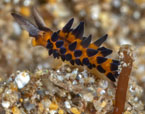
side
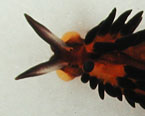
head
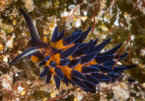
narrow band
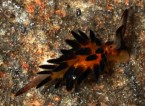
young, 2.5 mm
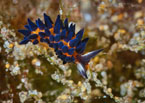
feeding?

probable egg mass

Placida kevinleei McCarthy, Krug & Valdes, 2017
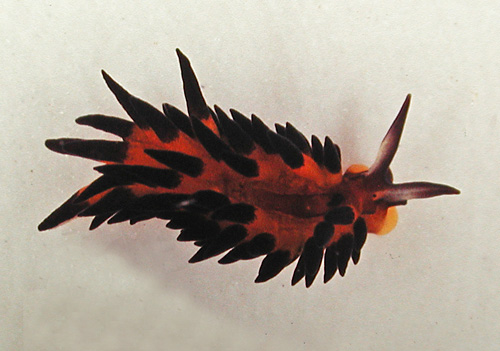
| Maximum size: 6 mm. Identification: This species has an orange body with a few small cream flecks. The distal half of the cerata, the ventral surfaces of the rhinophores and the sides of the head are velvet-black. The rhinophores have a diffuse dorsal white stripe confined to their bases (in contrast to the similar-appearing Placida barackobamai in which the rhinophores have sharply bounded white stripes extending their full length). (Note 1) Natural history: Placida kevinleei is a moderately common species found in moderately exposed to highly exposed rocky habitats at depths of 1-5 m (4-15 ft). According to McCarthy, et. al. (2017), it's been found to feed primarily on the filamentous green alga Derbesia sp. (Note 2) It probably lays a flattened, cream egg mass. Distribution: Big Island, Maui, Oahu and Kauai: also known from Japan (probably widely distributed in the western & central Pacific). Taxonomic notes: It was previously lumped (with Placida barackobamai) under the circumtropical species Placida cremoniana (Trinchese, 1893). The latter, however, was recently found to be a species complex as reported in McCarthy, J.B., P.J. Krug & A. Valdes, 2017. It was first recorded in Hawaii from Ko'ie'ie Fish Pond, outside Kalepolepo, Maui by PF on Nov. 18, 1991. Photo: PF: 5 or 6 mm: outside Ko'ie'ie Fish Pond, Kalepolepo, Maui; Nov.18, 1991. Observations and comments: Note 1: Although the basic pattern remains constant, the amount of black pigment on the rhinophores may increase with age. Note 2: McCarthy, et. al. (2017) suggests that its distinctive color pattern is aposematic coloration associated with the retention of toxins from its food algae. However, some of our animals may have been taken in beds of Sargassum echinocarpum and/or Sargassum polyphyllum. If that proves to be its primary habitat, perhaps the orange and black coloration actually evolved as camouflage when crawling on Sargassum spp.? Presumably, the filamentous Derbesia is growing on or under the larger algae... |
| Thumbnails |
Species
list |
Family | Next species | Top |